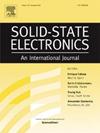ZnPc-based schottky diodes: Effect of amorphous polymer interlayers on electrical and structural properties
IF 1.4
4区 物理与天体物理
Q3 ENGINEERING, ELECTRICAL & ELECTRONIC
引用次数: 0
Abstract
This study investigates the influence of Indium Tin Oxide (ITO) electrode surface modification on the electrical properties of zinc phthalocyanine (ZnPc)– based Schottky diodes, using amorphous polymers, specifically polystyrene (Ps) and poly(butyl methacrylate) (PBMA). Devices with configurations of Al (Aluminum)/ZnPc/ITO, Al/ZnPc/Ps/ITO, and Al/ZnPc/PBMA/ITO were fabricated and analysed through current–voltage (I-V) characterisation. Devices modified with polymers showed significantly improved electrical performance, with the rectification ratio rising from 0.81 (pure ZnPc) to 4.24 for ITO modified with PBMA and 6.32 for ITO modified with Ps, along with optimised ideality factors and reduced series resistance. Space-charge-limited conduction (SCLC) became dominant, indicating enhanced charge mobility in the modified devices. UV–Vis analysis further confirmed this improvement, showing that PBMA modification enhances π–π* interactions and molecular aggregation within ZnPc thin films, reducing the optical bandgap from 3.05 eV to 2.75 eV (Ps) and 2.68 eV (PBMA), which indicates modified electronic properties due to polymer incorporation. Structural investigations employing XRR and AFM complement these findings, demonstrating improved crystallite size and a smoother surface, which lead to better charge transport. These results highlight the efficiency of polymer surface modification in enhancing ZnPc-based Schottky diodes, presenting intriguing possibilities for future optoelectronic applications.
zno基肖特基二极管:非晶聚合物中间层对电学和结构性能的影响
本研究研究了铟锡氧化物(ITO)电极表面改性对酞菁锌(ZnPc)基肖特基二极管电性能的影响,采用非晶态聚合物,特别是聚苯乙烯(Ps)和聚甲基丙烯酸丁酯(PBMA)。制备了具有Al (Aluminum)/ZnPc/ITO、Al/ZnPc/Ps/ITO和Al/ZnPc/PBMA/ITO结构的器件,并通过电流-电压(I-V)表征对其进行了分析。用聚合物修饰的器件表现出显著改善的电性能,整流比从0.81(纯ZnPc)上升到PBMA修饰的ITO的4.24和Ps修饰的ITO的6.32,同时优化了理想因子和降低了串联电阻。空间电荷限制传导(SCLC)成为主导,表明改进后的器件中电荷迁移率增强。UV-Vis分析进一步证实了这一改进,表明PBMA修饰增强了ZnPc薄膜内π -π *相互作用和分子聚集,将光学带隙从3.05 eV减小到2.75 eV (Ps)和2.68 eV (PBMA),这表明聚合物掺入修饰了电子性能。利用XRR和AFM的结构研究补充了这些发现,证明了改进的晶体尺寸和更光滑的表面,导致更好的电荷传输。这些结果突出了聚合物表面改性在增强znpc基肖特基二极管方面的效率,为未来光电应用提供了有趣的可能性。
本文章由计算机程序翻译,如有差异,请以英文原文为准。
求助全文
约1分钟内获得全文
求助全文
来源期刊

Solid-state Electronics
物理-工程:电子与电气
CiteScore
3.00
自引率
5.90%
发文量
212
审稿时长
3 months
期刊介绍:
It is the aim of this journal to bring together in one publication outstanding papers reporting new and original work in the following areas: (1) applications of solid-state physics and technology to electronics and optoelectronics, including theory and device design; (2) optical, electrical, morphological characterization techniques and parameter extraction of devices; (3) fabrication of semiconductor devices, and also device-related materials growth, measurement and evaluation; (4) the physics and modeling of submicron and nanoscale microelectronic and optoelectronic devices, including processing, measurement, and performance evaluation; (5) applications of numerical methods to the modeling and simulation of solid-state devices and processes; and (6) nanoscale electronic and optoelectronic devices, photovoltaics, sensors, and MEMS based on semiconductor and alternative electronic materials; (7) synthesis and electrooptical properties of materials for novel devices.
 求助内容:
求助内容: 应助结果提醒方式:
应助结果提醒方式:


